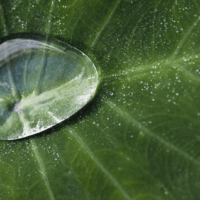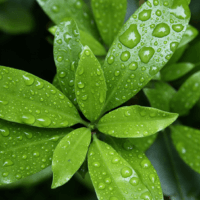This is the term for a medium or solution with a pH less than 7.0 as measured using a digital pH meter or with litmus paper. A lower pH is more acid.
Adding oxygen to a solution or adding a porous material to grow media to allow more oxygen to reach plant roots.
This method of growing plants suspends the plant roots in the air and fertigates the plants by misting the roots with a nutrient solution. The advantages of this system are that it is a highly oxygenated system and allows the grower to harvest plant roots without removing the plant. One of the disadvantages is that because very little if not zero media is used, the amount of time that the plants can survive in the event of pump failure is very limited. Also, because the plant roots must stay moist at all times, the pump must run continuously or extremely frequently which consumes more electricity and decreases pump longevity. The aeroponic method is used frequently in plant physiology when harvesting roots is necessitated, but due to the disadvantages of aeroponic methodology the commercial use for plant cultivation is limited. Aeroponics for plant propagation, however, is highly popular due to the rapid growth of roots associated with increased oxygen in the rhizosphere and the lack of media required to generate a new plant.
This is the term for a medium or solution which has a pH greater than 7.0; a higher pH is more alkaline. Also referred to as basic.
An addition to a growing medium which improves its structure, nutrient-content, water-holding capacity, cation exchange capacity or air porosity.
A plant hormone which promotes root development and stem elongation. The plant-created form is known as indole acetic acid (IAA), while the synthetically-produced form is indole-butryic acid (IBA).
-

Auxins’ role in plant propagation
Auxins are a class of plant hormones that are involved in all phases of plant growth and development, but are...
Single-celled microorganisms which can be beneficial or harmful to plant growth depending on species and function with respect to plants.
A term used in hydroponics which describes bacterial colonies which work synergistically with plants to defend against harmful diseases or fungi, increase the uptake of nutrients, and/or aid in the breakdown of organic materials.
The ability of a medium or solution to resist change in pH fluctuations.
A combination of carbon, hydrogen and oxygen. “Carbos,” or sugars and starches, are used to feed root zone beneficials.
Known as CO2, this odorless gas is an integral part of plant growth. Given the proper amount and spectrum of light, if CO2 levels are increased up to 1500 PPMs plant photosynthesis is increased dramatically. (Ambient air is usually in the range of 300-400 PPMs of CO2.)
Controlled Environment Agriculture, or greenhouse growing where an optimum environment for plants is maintained.
Cation Exchange Capacity. CEC is a measure of a grow medium or soil’s ability to hold positively charged ions.
A chemical compound composed of a metal ion and a chelating agent, usually organic such as an amino acid. Chelates bond with certain minerals to increase uptake in plants while preventing interactions with other minerals that could render minerals unavailable (lockout.)
General yellowing of a plant due to a lack of chlorophyll production during photosynthesis. This is typically caused by a pH imbalance, or nitrogen or iron deficiency.
Rooting a plant cutting to create another genetically identical plant.
-

Coconut Coir, Basics and Benefits
Coconut Coir is a widely used organic and renewable growth medium for both hydroponic and container gardening. Coir is made...
Decayed organic matter from plant or animal sources that can provide plants with nutrients needed for growth.
The first “leaves” of a dicot plant that emerge when a seed is planted that serve as the nutrient source until a plant develops roots for uptake of minerals.
A portion of a plant that is cut off to generate a new, identical plant by rooting.
A term used to describe the dieback of cuttings and seedlings caused by pythium fungi, or root rot.
Deep water culture (DWC) is the one of the oldest method of hydroponics to date. In this system, the plants roots are submerged in water that is aerated typically by using an air pump and air stone. The advantage to this system is the simplicity of technology and high level of humidity in the root zone. The disadvantage of this type of system is that if the source of oxygen in nutrient solution is reduced or fails, there is limited capacity for the plants to maintain vigor. This method is extremely productive and popular for production of lettuce, herbs, and other leafy greens.
A plant that has male and female organs on separate plants; one plant makes the flowers (female) and one plant makes the pollen (male.)
Drip feed hydroponics is one of the most popular methods of fertigating plants because of overall reliability, high performance, and low cost. In this method, plants are fed via a pump, injection system using water pressure, or gravity with a water tank to provide pressure to a series of drip lines that evenly distribute nutrient solution to all plant sites. The ability of the grower to control nutrition, moisture content of the growing media, and osmotic potential of the plant is easily achieved by varying concentration of the nutrient solution, volume of solution per irrigation cycle, and timing of irrigation intervals. The use of pressure compensated emitters will make the volume of solution distribution more uniform for larger systems or larger areas of irrigation.
Stands for the Electrical Conductivity of a solution. An EC meter is helpful in determining the concentration of minerals, nutrients or salts affecting plant growth; the higher the concentration, the more conductive the solution is.
When a plant begins to grow taller or longer in a fashion that creates a greater distance between the nodes of the plant.
Critical to the uptake of minerals and cooling of the plant, through movement of water within the entire plant. Can also be described as loss of water through evaporation.
To supply nutrients to plants via solution or a dry fertilizer.
-

Feeding and watering frequency: Drain-to-waste setups and coir based media
How often should you feed and water your plants? When growing plants in a drain-to-waste setup and using a nutrient...
Supplying fertilizer to a plant via its irrigation water.
-

Five pros and cons of growing organically in a hydroponic system
by Guest Author Annie S. White, Freelance Technical Writer & Horticultural Consultant. The marriage of hydroponics and organics makes an...
To remove buildup of salts from roots or media by using water or a specific solution designed for the purpose.
The leaves of a plant.
Spraying or misting a plant with nutrient solution which plants absorb through their leaves.
-

Foliar Feeding: Nutrients and Beneficial Bacteria
By Derex Q. Zellars | Environmental Scientist Traditional methods used to protect plants from disease have been largely based on...
-

Foliar Spraying
Olympians wear high compression swimsuits that are nothing short of technological marvels. They reduce drag and allow athletes to swim...
The liquid part of humus that is light golden in color and has the ability to increase uptake of nutrients into plant tissues.
Term used to describe the attributes of specific plants.
A naturally-occurring mineral complex that’s used to lower the pH of a grow medium.





